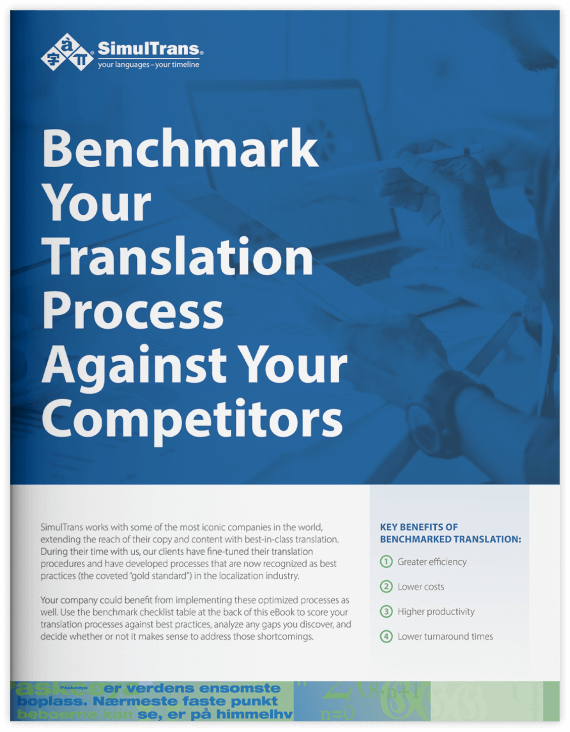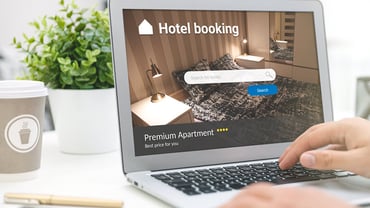


Website translation services
Website localization and translation by native speakers
Accuracy is far from the only concern when localizing a website. Translated content must be culturally relevant to international audiences, which often means replacing imagery, humor, and locale-specific references (while maintaining brand identity and search engine optimization [SEO] value).
Translated text must be imported into each localized page and match the layout of the source site.
For these reasons, SimulTrans goes way beyond translating text on our clients’ websites. Our process involves first understanding your products, messaging, and audiences, and establishing style and keyword guidelines. We also flag potential internationalization issues with language, photos, and illustrations.
Then, connectors to your CMS and marketing automation platform save you time by automating the process of requesting and receiving translations. You simply select pages and languages from your dashboard and receive ready-to-publish content when it’s complete (or if you prefer, you can send content and receive translations manually).
Our website localization services include the translation of:
- Web pages
- Landing pages
- Calls to action
- Blog posts
- Marketing PDFs
- Videos


How it works
- 1.We work together to build an understanding of your business and brand and establish guidelines for translation.
- 2.Send your files manually or connect your marketing platform to SimulTrans and export files directly from your dashboard. We’ll review your content and provide a quote for approval.
- 3.SimulTrans’ expert linguists translate your content into your requested languages on your schedule while flagging any potential internationalization issues.
- 4.SimulTrans’ reviewers check each translation for terminology accuracy and linguistic style.
- 5.As soon as a translation job is finished, translations are automatically imported into your marketing platform or sent to you, ready for publishing.
- 6.When you need updates or have more content to translate, SimulTrans uses translation memory to ensure you don’t pay to translate the same text twice.
Your long-term website translation partner
SimulTrans is the preferred website translation partner of so many leading brands because we’re able to meet all localization needs as businesses grow and change.
Our experienced team is always ready to work with you to find the best solution for your needs. This flexible, hands-on attitude is why we’ve been able to achieve a 97% customer satisfaction rate and remain a leader in the industry since 1984.
Benefits of partnering with SimulTrans:
- There’s never an added cost to you for the tools and technology we use to translate your materials.
- We’ll always suggest the most cost-effective solution for your needs.
- Translation memory saves time and money by reducing unnecessary rework while maintaining consistency.
- The SimulTracker portal keeps every project organized and improves collaboration between teams.
- We connect our systems to yours to automate ongoing translation projects, accelerating work and reducing admin needs.

Benchmark your Translation Process Against Your Competitors.
More insights

Improve AI Translations with Human Review

CMS and Translation Plugin Integration: What Clients Need to Know

Six Benefits of Using Translation Plugins Over Direct CMS Access
Frequently asked questions
How much does website translation cost?
Costs vary by language, typically corresponding to the cost of living in the target countries (for example, translation into Simplified Chinese is about a third of the cost of translation into Swedish). SimulTrans provides discounts based on repeated text by leveraging translation memory. Costs for formatting text and editing graphics or videos are calculated on a per-page basis.
Read this article for more information about website translation costs, or skip right to our estimate calculator.
Does SimulTrans translate SEO keywords?
Yes. Because speakers of different languages use search engines differently, keywords in one language may not be optimal in another. SimulTrans identifies international SEO keywords during the glossary development phase prior to translation of core web content, and applies these keywords consistently throughout your site. We can also work with predefined SEO keyword lists.
How long does website translation take?
Timelines depend on two factors: word count and team size. Each translator usually translates about 2,000 words per day, and our translators work simultaneously so the number of target languages won’t impact your timeline. Some additional time is required for formatting and testing.
We can accommodate almost any timeline by scaling your translation team. A typical team can have three translators and two reviewers per language, while some projects have over 100 translators per language!
Because websites grow and change, website localization projects are typically ongoing, with updates made monthly or even more frequently as needed. Your SimulTrans team will develop a custom workflow to support your ongoing website translation program.
.jpg)

